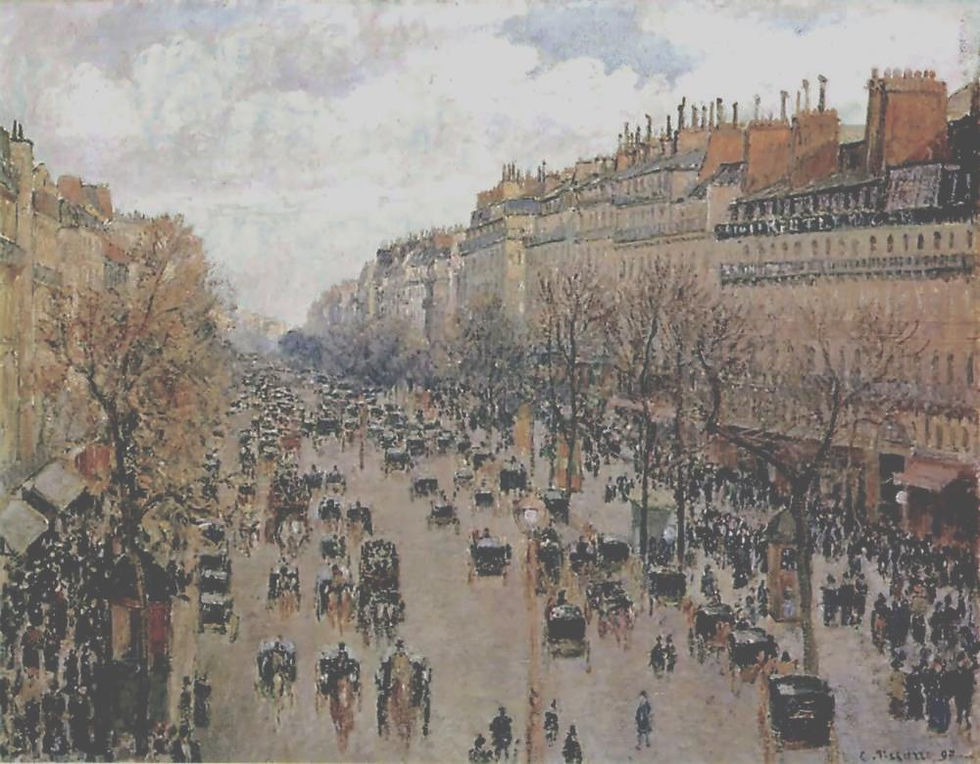PISSARRO at the Hermitage
- Ann Saul

- May 3, 2020
- 2 min read
#Pissarro #CamillePissarro #Hermitage #StateHermitageMuseum #StPetersburg #BoulevardMontmartre #Frenchart #Impressionism #ParisSalon #Grandjean #ChampsElysees #BeauxArts #Paris #DurandRuel #abstract #academicart #Haussmann #abstractpissarro #pissarrosplaces

Boulevard Montmartre, Afternoon, 1897, The State Hermitage Museum, St. Petersburg, Russia, PDRS 1165
One of the world’s great museums, the State Hermitage Museum in St. Petersburg, Russia is home to an extensive collection of French art. It is odd, therefore, that they only have two paintings by Camille Pissarro. One of those, Place du Théâtre-Français, the Omnibuses, Spring, Sunlight (1898) [PDRS 1209], was the subject of the previous post.
The other one, Boulevard Montmartre, Afternoon (1897) [PDRS 1165], was made the previous year when Pissarro stayed at the Grand Hôtel de Russie from February 8 to April 25, 1897. His dealer, Paul Durand-Ruel, bought 12 of the 16 paintings he made during that time, including this one.
He described the view from his window: “I can see down the whole length of the boulevards clear to the porte Saint-Denis, or nearly, at any rate all the way to the boulevard Bonne-Nouvelle.”* There is nothing of importance in the view—no great monument or imposing building. All of the new Haussmann apartments look the same. The drama is in Pissarro’s depiction of activity—omnibuses and carriages vying for space on the busy street, pedestrians crowding the sidewalks. The viewer is swept up and pulled along into the dense congestion. Everything on the sidelines becomes virtually abstract.
Pissarro’s scenes of Paris streets are so familiar that it is easy to forget how radical they were at the time—the loose brushstrokes capturing a horse in two quick strokes, mere dots of color for windows, white circular motions suggesting clouds.
Another Hermitage painting of a Paris street demonstrates the vast difference in Pissarro’s style and what art viewers of that day were accustomed to seeing. Edmond Grandjean (1844-1908) made his painting, View of the Champs-Elysées from the Place de l’Etoile, in 1878. Born in Paris, Grandjean studied at the Ecole Nationale Supérieure des Beaux-Arts. His paintings were exhibited frequently at the Paris Salon from 1865-1906.

Edmond Grandjean, View of the Champs-Élysées from the Place de l’Etoile in Paris, 1878
This painting is an excellent example of what Salon paintings looked like—and exactly what Pissarro was fighting against. It is almost photographic in its accuracy. Instead of colored blobs, the windows look as if they were carefully measured and squared. Grandjean was known for his depiction of horses, and even though they are small, the musculature in these horses is precise. Even the spokes of the wheels on carriages are delineated. The tiny people on the omnibuses are carefully modeled and costumed. This amount of details makes the painting look static, frozen in time. The book French Art Treasures at the Hermitage (Albert Kostenevich) says that this painting is “reminiscent of an illustration from a fashion journal transposed to a panorama: such pictures were extremely popular in the second half of the nineteenth century.” Compared to the Pissarro painting, this one looks like a picture on an old-fashioned tin candy box, with none of the life and vitality of the Pissarro. No wonder Pissarro’s paintings continue to fascinate and intrigue viewers after all these years.
*Pissarro: Critical Catalogue (2005)
ABSTRACT PISSARRO and PISSARRO’S PLACES,
books on Pissarro’s paintings, are available online
at Bookshop.org, AbeBooks,
Barnes and Noble, and Amazon.



Comments